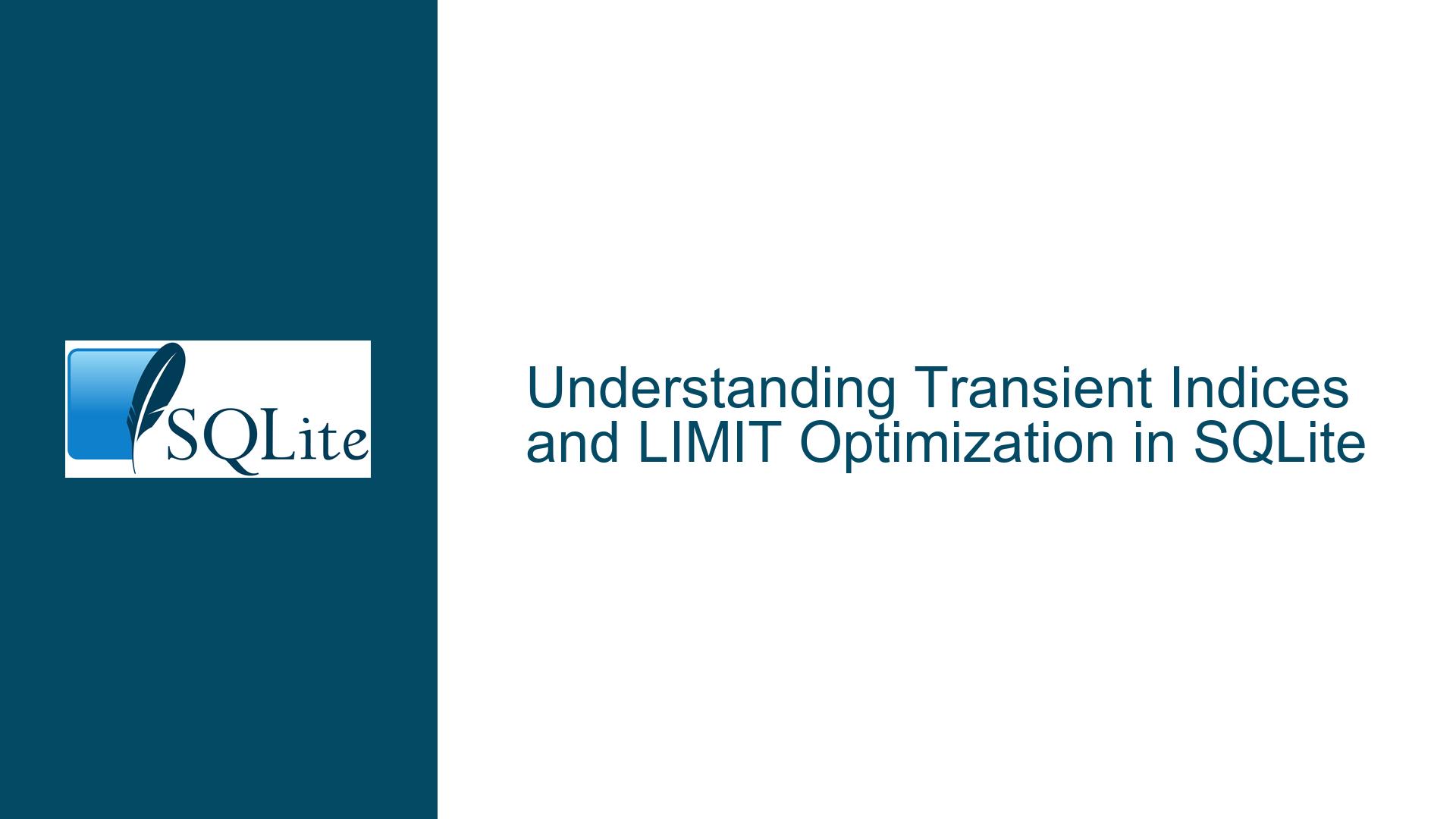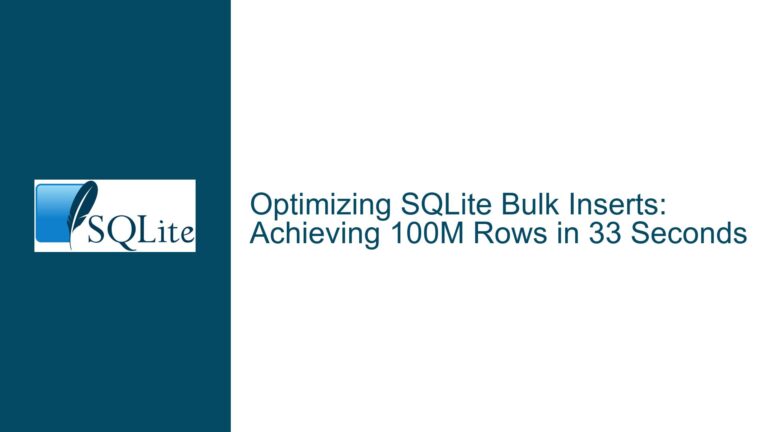Transient Indices and LIMIT Optimization in SQLite
Transient Indices and Their Impact on Query Performance with LIMIT
SQLite is a powerful, lightweight database engine that excels in many use cases, but like any database system, it has nuances that can significantly impact performance. One such nuance is the behavior of transient indices when combined with operations like DISTINCT, GROUP BY, ORDER BY, and LIMIT. This post delves into the mechanics of transient indices, their interaction with LIMIT, and how they influence query performance. We will explore the underlying issues, potential causes, and actionable solutions to optimize queries in SQLite.
How Transient Indices Work with DISTINCT, GROUP BY, and ORDER BY
Transient indices are temporary data structures created by SQLite to facilitate operations like sorting (ORDER BY), deduplication (DISTINCT), and grouping (GROUP BY). These indices are not persisted to disk and are discarded once the query execution completes. While they are essential for ensuring correct query results, their creation and maintenance can introduce performance overhead, especially when combined with LIMIT.
When a query includes ORDER BY or DISTINCT, SQLite typically constructs a transient index to sort or deduplicate the rows. This process involves reading all relevant rows from the table, constructing the index in memory (or on disk if memory is insufficient), and then applying the sorting or deduplication logic. The LIMIT clause is applied only after this process is complete, meaning that SQLite must process all rows before returning the limited subset.
For example, consider a query like:
SELECT DISTINCT column FROM table ORDER BY column LIMIT 10;
In this case, SQLite will:
- Read all rows from
table. - Construct a transient index to deduplicate and sort the values in
column. - Apply the
LIMIT 10clause to the sorted and deduplicated result set.
This approach ensures correctness but can be inefficient for large datasets, as the transient index must handle all rows, even if only a small subset is ultimately returned.
Why Transient Indices and LIMIT Don’t Always Optimize Well
The inefficiency arises because SQLite does not currently employ advanced optimization techniques, such as maintaining a small heap or priority queue, to handle LIMIT clauses more efficiently. Instead, it processes the entire dataset before applying the limit. This behavior is particularly noticeable in queries that combine DISTINCT, ORDER BY, and LIMIT.
For instance, if you have a table with 20 million rows and run a query like:
SELECT DISTINCT column FROM table ORDER BY column LIMIT 10;
SQLite will:
- Read all 20 million rows.
- Deduplicate and sort them using a transient index.
- Return the top 10 rows.
Even though only 10 rows are needed, SQLite incurs the overhead of processing all 20 million rows. This is because the transient index must account for all possible values to ensure correctness.
The issue is compounded by the fact that transient indices may spill to disk if they exceed available memory. This results in additional I/O operations, further degrading performance. While SQLite is designed to handle such scenarios gracefully, the overhead can be significant for large datasets.
Strategies to Optimize Queries with LIMIT and Transient Indices
To address the performance issues associated with transient indices and LIMIT, several strategies can be employed. These include leveraging existing indices, restructuring queries, and employing advanced techniques to minimize the overhead of transient indices.
Leveraging Existing Indices
One of the most effective ways to optimize queries is to ensure that the relevant columns are indexed. For example, if you frequently run queries like:
SELECT DISTINCT column FROM table ORDER BY column LIMIT 10;
You can create an index on column:
CREATE INDEX idx_column ON table(column);
This allows SQLite to use the existing index for sorting and deduplication, potentially avoiding the need for a transient index altogether.
Restructuring Queries
In some cases, restructuring the query can reduce the need for transient indices. For example, if you only need a small subset of rows, consider using subqueries or window functions to narrow down the dataset before applying DISTINCT or ORDER BY.
For instance, instead of:
SELECT DISTINCT column FROM table ORDER BY column LIMIT 10;
You could use:
SELECT column FROM (SELECT column FROM table ORDER BY column LIMIT 100) GROUP BY column LIMIT 10;
This approach reduces the number of rows processed by the transient index, as the subquery limits the dataset to 100 rows before applying DISTINCT and LIMIT.
Advanced Techniques: Heaps and Priority Queues
While SQLite does not currently support advanced optimization techniques like heaps or priority queues for LIMIT clauses, you can implement similar logic in your application code. For example, you can:
- Read rows from the table in batches.
- Maintain a small heap or priority queue in memory to track the top
krows. - Stop processing once the heap contains the desired number of rows.
This approach minimizes I/O and memory usage by avoiding the need to process the entire dataset.
Monitoring and Tuning
Finally, monitoring query performance and tuning SQLite’s configuration can help mitigate the impact of transient indices. For example:
- Use
EXPLAIN QUERY PLANto analyze how SQLite executes your queries. - Adjust the
cache_sizeandtemp_storesettings to optimize memory usage for transient indices. - Consider using
PRAGMA journal_mode = OFFto reduce write overhead during query execution.
By combining these strategies, you can significantly improve the performance of queries that involve transient indices and LIMIT.
Conclusion
Transient indices are a powerful feature of SQLite that enable correct and efficient execution of queries involving DISTINCT, GROUP BY, and ORDER BY. However, their interaction with LIMIT can lead to performance issues, particularly for large datasets. By understanding the underlying mechanics, leveraging existing indices, restructuring queries, and employing advanced techniques, you can optimize your queries and minimize the overhead of transient indices. With careful tuning and monitoring, SQLite can deliver excellent performance even in demanding use cases.






